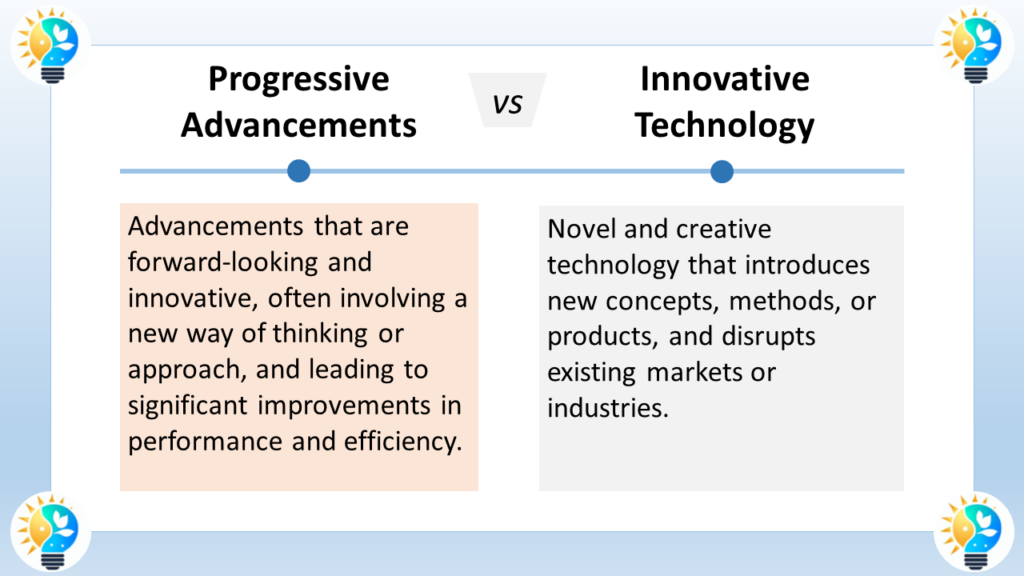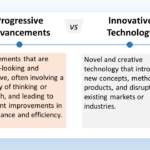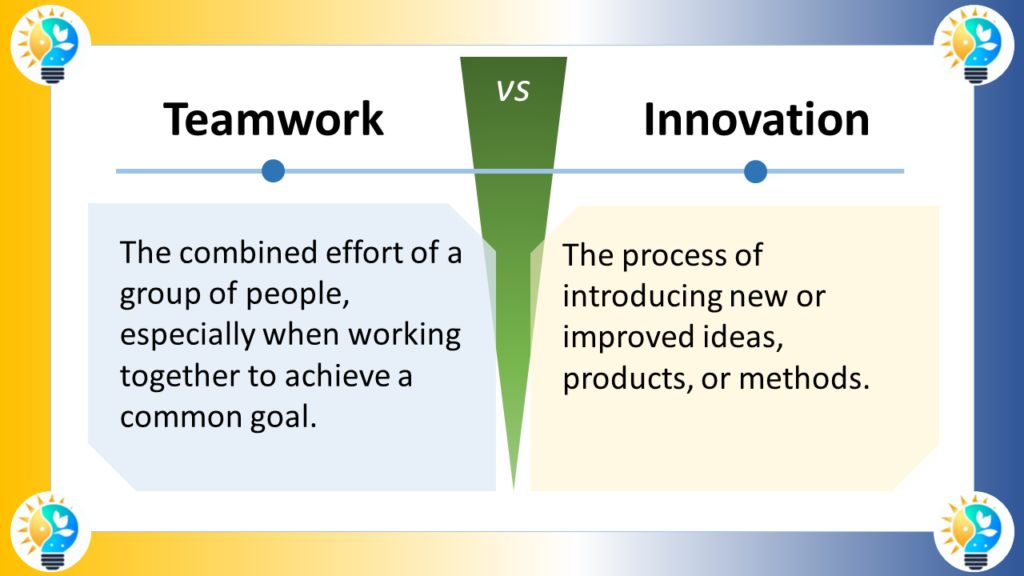Both progressive advancements and innovative technology drive improvements, but while progressive advancements focus on forward-looking innovations, innovative technology actively introduces new concepts or products to achieve efficiency gains.

The evolution of technology is marked by constant change and improvement, with terms like Innovative Technology and Progressive Advancements often used to describe this forward trajectory. While they share common traits, they represent different aspects of technological evolution.
Definition
Defining Innovative Technology
Innovative Technology encompasses new or significantly improved technologies that provide better solutions than those currently available. It emphasizes the introduction of novel concepts or enhancements to existing technologies.
Characteristics of Innovative Technology
- Novelty: Introduces new methods, ideas, or devices.
- Improvement: Aims to enhance performance, efficiency, or user experience.
- Solution-oriented: Focuses on addressing specific problems or market needs.
Defining Progressive Advancements
Progressive Advancements, on the other hand, are the steady and continuous developments that occur within technology over time. They represent the cumulative effect of incremental improvements and refinements that collectively propel technology forward.
Characteristics of Progressive Advancements
- Incremental: Involves step-by-step improvements rather than radical changes.
- Evolutionary: Reflects the natural evolution of technology as it adapts and matures.
- Continuous: Represents an ongoing process rather than isolated events.
Exploring a Variety of Synonyms for Innovative Technology
- Advanced Technology
- Cutting-Edge Innovations
- Cutting-Edge Breakthroughs
- Disruptive Tech
- Emerging Technologies
- Forward-Looking Tech
- Futuristic Innovations
- Groundbreaking Developments
- High-Tech Breakthroughs
- Innovative Breakthroughs
- Inventive Solutions
- Leading-Edge Advancements
- Modern Technological Breakthroughs
- Progressive Advancements
- Next-Generation Technology
- Novel Tech
- Revolutionary Tech
- State-of-the-Art Solutions
- State-of-the-Art Innovations
- Trailblazing Innovations
- Visionary Tech

Innovation is considered as a driving force in progress.
It includes the introduction of novel ideas, methods, or products that bring positive change and advancement.
For more information about innovations, check our glossary
Innovative Technology vs. Progressive Advancements: Relationship and Relevance
Innovative Technology can often be a catalyst for Progressive Advancements. An innovative technology might introduce a new concept that, over time, leads to a series of progressive advancements as the technology is refined and optimized.
Contextual Use of the Terms
In a business setting, companies may introduce innovative technology to disrupt the market or create new opportunities. Progressive advancements, however, are utilized to maintain a competitive edge through continuous improvement and adaptation to changing industry standards.
Examples of Utilization
The creation of the smartphone was an innovative technology that combined the functionality of a phone, computer, and camera into one handheld device. It fundamentally changed how people communicate and access information.
The ongoing enhancements in smartphone battery life, camera quality, and processing power are examples of progressive advancements. These are not necessarily groundbreaking in isolation, but over time they significantly improve the user experience and capabilities of smartphones.
Comparison innovative technology vs progressive advancements
The difference between innovative technology and progressive advancements lies in their nature and impact. Let’s break it down:
- Innovative Technology:
- Innovative technology refers to the development and introduction of new and novel technologies [2].
- It involves the creation of something that is different and groundbreaking, often bringing about significant changes in various domains [2].
- Innovative technology is characterized by its novelty, fast growth, and potential to have a considerable impact on society [2].
- Examples of innovative technologies include artificial intelligence, robotics, nanotechnology, biotechnology, and information technology [2].
- The focus of innovative technology is on creating new solutions, products, or processes that can revolutionize industries and improve efficiency or effectiveness.
- Progressive Advancements:
- Progressive advancements, on the other hand, refer to the gradual improvement or advancement of existing technologies, processes, or systems [1].
- It involves building upon what already exists and making incremental changes to enhance performance, functionality, or efficiency [1].
- Progressive advancements are characterized by their continuity and the accumulation of knowledge and resources over time [1].
- These advancements may include improvements in existing technologies, such as updates, upgrades, or refinements, to make them more effective or efficient.
- The focus of progressive advancements is on refining and optimizing existing technologies or processes to achieve better outcomes.
In summary, innovative technology involves the introduction of new and groundbreaking technologies, while progressive advancements focus on the gradual improvement and refinement of existing technologies or processes.
FAQ
Q: Is every innovative technology a progressive advancement?
A: While every innovative technology has the potential to lead to progressive advancements, not all will do so. The impact of an innovative technology depends on its adoption, utility, and the further improvements it inspires.
Q: How do businesses decide between implementing innovative technology or focusing on progressive advancements?
A: The decision often depends on the company’s goals, resources, and market positioning. Disruptive companies may prefer innovative technology, while established companies might focus on progressive advancements to refine their offerings.
Q: Are progressive advancements always predictable?
A: Not always. While they’re typically predictable in nature, unexpected discoveries or applications can accelerate progress or take it in new directions.
Q: Can adopting progressive advancements be risky for a company?
A: The risks associated with adopting progressive advancements are generally lower compared to implementing innovative technology, as they involve more gradual changes and are often based on proven technologies.
Q: How do progressive advancements impact the workforce?
A: Progressive advancements can require the workforce to engage in ongoing learning and adaptation, as they often lead to changes in processes, tools, and methodologies used in the workplace.


